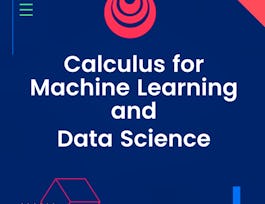Newly updated for 2024! Mathematics for Machine Learning and Data Science is a foundational online program created by DeepLearning.AI and taught by Luis Serrano. In machine learning, you apply math concepts through programming. And so, in this specialization, you’ll apply the math concepts you learn using Python programming in hands-on lab exercises. As a learner in this program, you'll need basic to intermediate Python programming skills to be successful.


Probability & Statistics for Machine Learning & Data Science
This course is part of Mathematics for Machine Learning and Data Science Specialization

Instructor: Luis Serrano
66,754 already enrolled
(449 reviews)
Recommended experience
What you'll learn
Describe and quantify the uncertainty inherent in predictions made by machine learning models
Visually and intuitively understand the properties of commonly used probability distributions in machine learning and data science
Apply common statistical methods like maximum likelihood estimation (MLE) and maximum a priori estimation (MAP) to machine learning problems
Assess the performance of machine learning models using interval estimates and margin of errors
Skills you'll gain
Details to know

Add to your LinkedIn profile
8 assignments
See how employees at top companies are mastering in-demand skills

Build your subject-matter expertise
- Learn new concepts from industry experts
- Gain a foundational understanding of a subject or tool
- Develop job-relevant skills with hands-on projects
- Earn a shareable career certificate


Earn a career certificate
Add this credential to your LinkedIn profile, resume, or CV
Share it on social media and in your performance review

There are 4 modules in this course
In this week, you will learn about probability of events and various rules of probability to correctly do arithmetic with probabilities. You will learn the concept of conditional probability and the key idea behind Bayes theorem. In lesson 2, we generalize the concept of probability of events to probability distribution over random variables. You will learn about some common probability distributions like the Binomial distribution and the Normal distribution.
What's included
30 videos9 readings2 assignments1 programming assignment4 ungraded labs
This week you will learn about different measures to describe probability distributions as well as any dataset. These include measures of central tendency (mean, median, and mode), variance, skewness, and kurtosis. The concept of the expected value of a random variable is introduced to help you understand each of these measures. You will also learn about some visual tools to describe data and distributions. In lesson 2, you will learn about the probability distribution of two or more random variables using concepts like joint distribution, marginal distribution, and conditional distribution. You will end the week by learning about covariance: a generalization of variance to two or more random variables.
What's included
27 videos2 readings2 assignments1 programming assignment3 ungraded labs
This week shifts its focus from probability to statistics. You will start by learning the concept of a sample and a population and two fundamental results from statistics that concern samples and population: the law of large numbers and the central limit theorem. In lesson 2, you will learn the first and the simplest method of estimation in statistics: point estimation. You will see how maximum likelihood estimation, the most common point estimation method, works and how regularization helps prevent overfitting. You'll then learn how Bayesian Statistics incorporates the concept of prior beliefs into the way data is evaluated and conclusions are reached.
What's included
20 videos3 readings2 assignments2 ungraded labs
This week you will learn another estimation method called interval estimation. The most common interval estimates are confidence intervals and you will see how they are calculated and how to correctly interpret them. In lesson 2, you will learn about hypothesis testing where estimates are formulated as a hypothesis and then tested in the presence of available evidence or a sample of data. You will learn the concept of p-value that helps in making a decision about a hypothesis test and also learn some common tests like the t-test, two-sample t-test, and the paired t-test. You will end the week with an interesting application of hypothesis testing in data science: A/B testing.
What's included
22 videos8 readings2 assignments1 programming assignment1 ungraded lab
Instructor

Offered by
Recommended if you're interested in Algorithms

DeepLearning.AI

Databricks

DeepLearning.AI

DeepLearning.AI
Why people choose Coursera for their career




Learner reviews
Showing 3 of 449
449 reviews
- 5 stars
78.22%
- 4 stars
12.88%
- 3 stars
4.22%
- 2 stars
1.77%
- 1 star
2.88%
New to Algorithms? Start here.

Open new doors with Coursera Plus
Unlimited access to 7,000+ world-class courses, hands-on projects, and job-ready certificate programs - all included in your subscription
Advance your career with an online degree
Earn a degree from world-class universities - 100% online
Join over 3,400 global companies that choose Coursera for Business
Upskill your employees to excel in the digital economy
Frequently asked questions
Access to lectures and assignments depends on your type of enrollment. If you take a course in audit mode, you will be able to see most course materials for free. To access graded assignments and to earn a Certificate, you will need to purchase the Certificate experience, during or after your audit. If you don't see the audit option:
The course may not offer an audit option. You can try a Free Trial instead, or apply for Financial Aid.
The course may offer 'Full Course, No Certificate' instead. This option lets you see all course materials, submit required assessments, and get a final grade. This also means that you will not be able to purchase a Certificate experience.
When you enroll in the course, you get access to all of the courses in the Specialization, and you earn a certificate when you complete the work. Your electronic Certificate will be added to your Accomplishments page - from there, you can print your Certificate or add it to your LinkedIn profile. If you only want to read and view the course content, you can audit the course for free.
If you subscribed, you get a 7-day free trial during which you can cancel at no penalty. After that, we don’t give refunds, but you can cancel your subscription at any time. See our full refund policy.